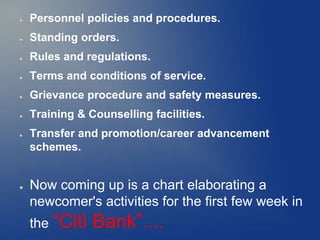Induction Programme, an Orientation by the Human Resource Department
- 1. INDUCTION Entering an Organisation
- 2. INDUCTION ● It is concerned with introducing/orienting a new employee to the organisation. It is the welcoming process to make the new employees feel at home and generate in him/her a feeling of belongingness to the organisation. ● It is the first step in an effective communication which seeks to build a two way channel of information between the management and the employees.
- 3. ● To give the new employee information and knowledge of the company, its organisation structure and products. ● To foster a close and cordial relationship between the newcomers and the old employees and their supervisors. ● To ensure that the newcomers do not form false impression and negative attitude towards the organisation or the job because the first impression is the last impression. ● To promote among employees a feeling of “belonging” and loyalty to the company.
- 4. Objectives Of INDUCTION ● To build up the new employee's confidence in the company and in himself, so that he can become an efficient worker. ● To give him information that he needs, such as the time to break for lunch, where to find the canteen, the wash room etc., what leave he is entitled to and how to apply for it, and so on.
- 5. Significance The basic purpose is to introduce the new employee and the organisation to each other, to help them become acquainted, and to help them accommodate each other. The employee is explained what is expected of him and is also told the rules, regulations, policies and procedures that directly affect him. He is made aware of his own duties and responsibilities, and to whom he should look for when he has any problem or difficulty.
- 6. This shows how significant it is to properly induce an employee to his work and the organisation itself. Careful introduction to his job will make his adjustment to the job more rapid, his mistake fewer and his attitude more co-operative which will be in the best interest of the organisation and the personnel as well.
- 7. Benefits Of Induction ● Helps in knowing the organisation, executives and other people and all their expectations. ● Explains how he and his unit fits into the “BIG PICTURE” and fosters an uniform understanding. ● Builds a positive attitude for the organisation. ● Forms a two-way bond with the organisation. ● Instils a sense of belongingness in the newcomer.
- 8. Topics Covered In An INDUCTION PROGRAMME ● Company's history, vision, mission and philosophy. ● Company's organisation structure, departments and employee services. ● Products and services of the company. ● Employees' benefits and services like clubs, credit society etc.
- 9. ● Personnel policies and procedures. ● Standing orders. ● Rules and regulations. ● Terms and conditions of service. ● Grievance procedure and safety measures. ● Training & Counselling facilities. ● Transfer and promotion/career advancement schemes. ● Now coming up is a chart elaborating a newcomer's activities for the first few week in the “Citi Bank”....
- 11. General Practices And Procedure Induction can be an informal act in small firms or formal lasting for 2-4 weeks in case of big ones. Even if an elaborate orientation is due after few weeks, an immediate informative introductory induction should be provided in the beginning. The procedure usually consists these steps: ● The newcomer should get a definite time and place to report. ● The supervisor/immediate boss should welcome the new employee to the organisation on his first day.
- 12. ● Information about working hours, vacations, probationary period, suggestion system, etc. should be conveyed to the employee. ● Departmental orientation includes introduction to the department, functional and job instructions and personnel to look for help and guidance if any problem. ● Verbal explanations supplemented with a wide variety of printed material, employee handbook, pamphlates etc., alongwith short guided tour. ● The induction program is to be handled by one who is fully conversant with the course contents. The success of this course depends upon the quality of trainers.
- 13. Now here is a short example of an induction video....
- 14. Tips For Effective Induction ● Orientation should be thoroughly planned and those conducting it should give due attention to specific problems faced by new employees. ● Supervisors should be trained in the art of orientation of new workers. Thus, induction should be treated as a special duty. ● Orientation should be a gradual process. The participants should not be overloaded with too much information.
- 15. ● The new employee should be informed about the rules that apply to him as well as the specific work situation and job requirements. ● Human side is the most important part of orientation. Therefore, first of all the new employee should be introduced to the people with whom he will work- his colleagues, superiors and subordinates. ● The supervisors should answer the questions and clarify the doubts that the employee may have about the job or the organisation.
- 16. Well, what if it doesn't go as planned....
- 17. That's All Folks BY SHASHANK GUPTA B.COM(H), Ist YEAR PGDAV COLLEGE, DU

















